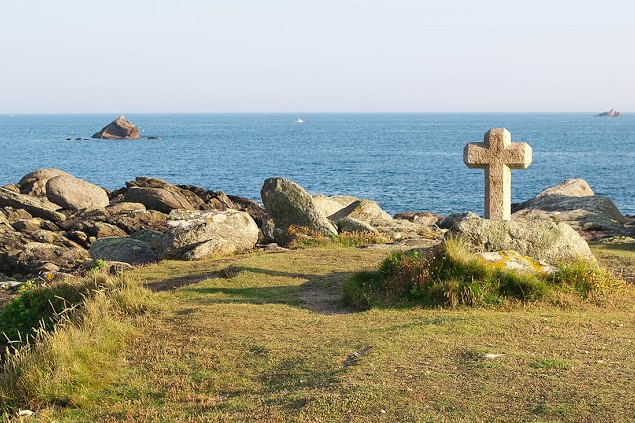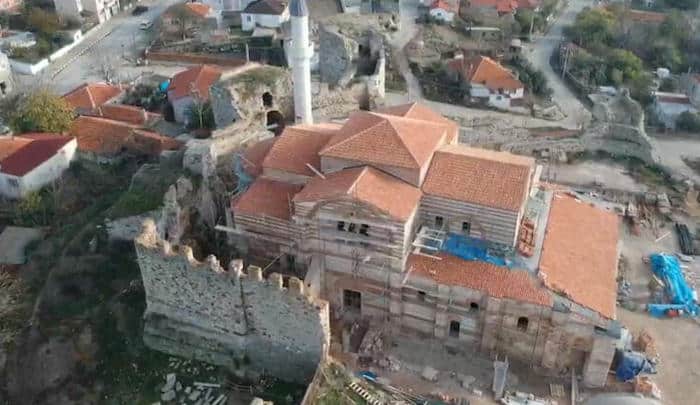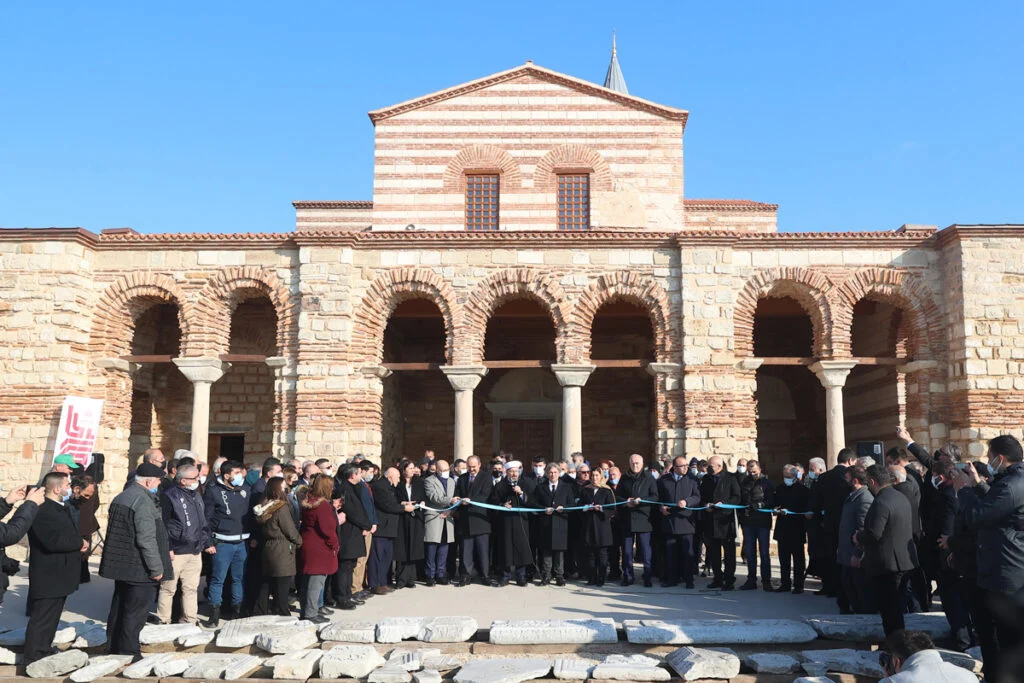Administration
Existing from 1878 until 1912, this Ottoman sancak comprised the three kazas of Dedeağaç, Sofulu (Grk. Σουφλί – Soufli), and Enez.
Population
The Greek Orthodox Diocese of Ainos (Αίνος; Trk.: Enez) was divided into two parts — that of Ainos proper and the kaza of Alexandroupoli (Αλεξανδρούπολη; Trk.: Dedeağaç). The diocese comprised seventeen communities and had a population of 10,057 Greeks.[1]
Town of Enez / Αίνος – Ainos
Toponym
In antiquity, the place was called Ainos/Aenus. The mythical and eponymous founder of the ancient Greek city of Ainos/Aenus was said to be Aeneus, a son of the god Apollo and father of Cyzicus. Presumably because of the similarity of the names, Virgil has Aeneas found the city after the destruction of Troy.
Another mythical ruler, named Poltys, son of Poseidon, entertained Heracles when he came to Aenus. On that occasion, Heracles slew Poltys’ insolent brother Sarpedon on the beach of Aenus. According to Strabo, Sarpedon is the name of the coastline near Aenus, so both Poltys and Sarpedon would appear to be eponyms.
History
Ainos originated around 6500 B.C. as a fishing town. Enclosed by water from three sides, Ainos was an ancient port city in Eastern Thrace on the east bank of the Evros (Hebrus, also Maritsa) River. Ainos is already mentioned in Homer, Iliad 4, 520, and in Herodotus IV 90. The place was founded as an Aiolian colony of Mytilene and Kyme in the 7th century B.C. The city became prosperous through trade and agriculture, and as a member of the 1st Attic-Delic Naval League paid high tributes. Ainos fought on the side of Athens in the Peloponnesian War and became a member of the 2nd Attic Naval League in 375 B.C. From 341 to 185 B.C., Ainos belonged to the empire of the Attalids of Pergamum, who bequeathed Ainos with their entire empire to the Romans.
In late antiquity, the town was the episcopal see and capital of the small province of Rhodope. Prokop (De Aedificiis 4, 11, 1-5) reports that Emperor Justinian I had the walls of the city expanded into a fortress.
In place of the ancient acropolis stands a medieval castle of the Genoese family of the Gattilusio, who ruled the city as a Genoese colony from 1376 until its occupation by the Ottoman Sultan Mehmed II in 1456.
With the gradual Ottoman conquest of Thrace in the 1360s and 1370s, the city became a haven for the Greek population. From ca. 1384 on the city came under the rule of the Genoese Gattilusio family, beginning with Niccolo Gattilusio. The Gattilusi maintained their possession by exploiting the city’s wealth, chiefly deriving from the area’s salt pans and fisheries, and sending an annual tribute to the Ottomans. Niccolo Gattilusio was deposed by his son Palamede in 1408/9, who ruled until his death in 1454. His younger son, Dorino II, squabbled with Helena Notaras, the widow of Niccolo’s elder son Giorgio Gattilusio and ruled only for two years. Helena Notaras appealed to the Ottoman Sultan Mehmed II who attacked the city from land and sea and forced its surrender in January 1456.
In 1463 Ainos was given by Mehmed II to the deposed Despot of the Morea, Demetrios Palaiologos, as an appanage (along with parts of Thasos and Samothrace). He remained in possession of the town until 1467, when he fell into disgrace. The Venetians briefly captured the city in 1469.
After the First Balkan War (1912), the city was initially intended as a border with Bulgaria (Treaty of London, 1913), which was corrected in Ottoman favor a few months later after the Second Balkan War (Peace of Bucharest, 1913).
Ecclesiastical history
The city was an episcopal see already in the 4th century: bishop Olympius under Constantius II. At first it was a suffragan of Trajanopolis, the capital and metropolitan see of the Roman province of Rhodope, but by the time of the Notitia Episcopatuum of Pseudo-Epiphanius (c. 640), it was an autocephalous archbishopric, and rose to a separate metropolitan see (without suffragans) at the end of the 11th century. Its bishop Olympius was driven from the see by the Arians under Constantius II. Macarius took part in the Council of Chalcedon (451), Paul in the Second Council of Constantinople (553), George in the Trullan Council of 692, and John in the Photian Council of Constantinople (879). Another John took part in the Council of 1030/38, and Michael in the councils of 1092 and 1094.
Between 1285 and 1315, the see was awarded to the Metropolitan of Antioch in Pisidia. In 1361 the see was awarded to the Metropolitan of Makre, two years later to the Metropolitan of Sougdaia and in 1369 to the Bishop of Athyra. It remained a residential see of the Greek Orthodox Church until the 1923 forced population exchange between Greece and Turkey and is now a titular metropolis.

Destruction
“The disturbances created by the Balkan War brought about a deplorable state of affairs in this locality. Under the rule, for a little over one year, of no less than five authorities (Turkish Comitadjis [irregulars], Bulgarian, Hellenic, Autonomous Administration, and again Bulgarian as regards the district of Dedeagatch [Dedeağaç] and Turkish for that of Enos [Enez]) the inhabitants of this diocese were compelled to put up with all kinds of terrible experiences while striving hard to safeguard their lives and honor.
The activity displayed by the Bulgarian occupation combined with a systematic anti-Greek policy, particularly after the re-occupation, were such as to bring about at last a complete national decline of the Greeks. The Bulgarians did not lack methods of terrifying the people. Reasons of a geographical, military and ethnological nature in this important region concurred for the maintenance of a fixed camp, withdrew these lands for a certain time, from Bulgarian rule. But when once the Bulgarians succeeded in putting their foot once more in the town of Dedeagatch, they gave way without restraint to their feelings of fanaticism against everything that was Greek, committing the most frightful atrocities against its Greek population. Churches were desecrated, schools were closed, shops were plundered, trade came to a standstill, economical life lost its vitality, and as a crowning act of Bulgarism, a price was put on the head of the Metropolitan of Enos, a man who had been instrumental in saving the lives of many thousand Bulgarians at the time of the Autonomous Administration from the revengeful hands of the Turks.
At the present moment [1919] not a single Greek is to be found in the town and district of Dedeagatch, most of them having for one reason or the other, been obliged to emigrate to Greece.
It is true that the destruction of this district had already begun at the time of the retreat of the Turkish troops, when the Army of General Yaver Pasha burnt the village of Roumdloulis, dispersed its inhabitants and plundered the market of Serres, accompanied by murder. This destruction was, however, completed under the Bulgarian rule.
At the time of the re-occupation of Thrace the small district of Enos suffered at the hands of the Turks. Many of the inhabitants were unmercifully beaten; others were unjustly thrown into prison, and only released after the energetic steps taken in this matter by the Metropolitan.
Shortly after, the usual deportation of all the Greek inhabitants of the district began.
Persecutions in 1914.
- AHIR KEUY [Ahirköy]. — Two murders were committed at the time of the re-occupation. In 1914, the village sustained three successive attacks from the Turkish bands, and was completely plundered. Five inhabitants died through ill-treatment. The remainder abandoned the village, took refuge in that of Karpouli, whence they were expelled to Greece (13th June, 1914), after being previously beaten and robbed by the Custom House Authorities of all their savings.
2. TSELEPI, 3. KEMERLI, 4. ARVANITES.— At Easter time (April, 1914), the inhabitants of the villages were surrounded by Turkish bands, who fired on them, and forced them to take refuge at Enos, whence they were expelled to Greece, being previously robbed of everything. Among the deported was the head of the patriarchal Monastery of St. Athanass Tchantiri, Pope Yoachim, who was beaten on more than one occasion. Constantine loannou, of the village of Kemerly, was hanged.
5. DOUKIENI. — After a protracted siege, followed by plunder, the inhabitants of this locality shared the same fate as those of other villages. Four were killed: Zafiris Angelos, and Nicolaos Zafiriades and their workman Athanassios.
6. AGIASMA. — This village was besieged and forced to pay a ransom. The priest of the village was obliged to pay a sum of money to the aggressors, who carried away two girls of the village of Stefanaki, along with the school-mistress, whom they released after receiving Ltq.200. Owing to repeated attacks, followed by plundering, the inhabitants sought refuge in Greece.
7. KOZKORI. — For similar reasons the Greek population of this place also emigrated to other parts. It was subsequently occupied by Turkish emigrants, which was generally the case with the remainder of the villages that were evacuated.
(b) Deportation during the European War.
8. AMIGDALIA and 9. MAISTROS. —Before even they were officially notified by the Government to quit, the inhabitants in order to escape persecution and robbery by the Turks, sought refuge in the monasteries of Skalotis and Aghios Pandeleimona. On their return sometime later on, they were again driven out (April, 1915) within three hours, the inhabitants of Amigdalia settling down in the village of Pesait, those of Maistros resorting to Kastritsa. Two shepherds of Achileos Niotis, from Maistros, by name Christos and Bozicos, as well as two others of Amigdalia, were murdered.
10. ENOS. — Both during the Balkan and European wars this town was made the particular objective by Government officials and its Moslem inhabitants, as being a place of special importance from which the Greek element should be deported. This scheme was successfully carried out in August, 1915, when the inhabitants were expelled to Malgara. Out of a total of seventeen churches, fifteen were destroyed. The library containing 1,900 volumes was pillaged. The monastery of Skalotis was burnt, and those of Aghios Panteleimon and Tsandiri completely demolished.
Thus was brought about the destruction of that Diocese which had been officially planned and carried out by the Turks, as proved by the deposition of the Chief of Police of Enos, Yussuf Zia Bey. The revelations, contained in a letter addressed by Zia Bey to the French Consul of Callipoli [Gallipoli], of which we give a translation of the exact copy, bring to light considerable important facts.
‘To His Excellency, The French Consul, at Gallipoli.
I, the undersigned, Chief of Police of Enos, was arrested through calumny brought against me by the sub-governor of Gallipoli and while under an escort of gendarmes like a criminal, succeeded in making my escape and taking refuge in the Austrian Consulate of this city.
Looking upon you as representing a great Protecting Power of the Albanians, I hope you will do what is due to me. My arrest is due to personal reasons of the Caimacliam [Kaymakam] who, wishing to revenge himself on me, owing to my conscientious attitude, accused me of having extorted money from different persons. No sooner had I taken refuge in the Austrian Consulate, than the Governor of Gallipoli sent the Chief of Police to persuade me to go to his Residence. I then declared in the presence of witnesses, that of late, acts of pillage and oppression have been committed against the Christians; that whole villages are evacuated at the instigation and by order of the present Government and that this is well known to all. I consider it to be expedient to give you a brief statement of the events that took place at Enos.
I went to Enos on the 9th of May, 1914. As soon as the Caimacham [Kaymakam] (Governor) saw me he said to me : ‘The Greeks here are pro-Hellenes, so take care.’ I found out, however, during the Bulgarian occupation, that the Greeks protected the Turks.
Petitions from all quarters were addressed to the Caimacham, who took no notice of them whatsoever. Instead of which he sent to the spot the Lieutenant of the gendarmerie a few days ago, who recommended stricter measures to these bands; he returned to Enos. He personally supervised the embarkation by force of the inhabitants of the village Kodja-ali [Kocaali] on sailing vessels, at Dracodina, and sent them to Samothrace after confiscating their cattle and carts. And while the whole of the district of Enos was being plundered, and its inhabitants deported, he sent false telegrams to the Government, to the civil prefecture and inspection, assuring them that order had been established, that no incident had taken place, and that only the inhabitants of the village Kodja-Ali had secretly disappeared! At that time the Mutasserif [mutasarrif] arrived at the village of Kiz Kapou [Kizkapı] of Kessani [Keşan]. Scarcely did the news reach the Caimacham, than he hastened to meet him, and having received instructions he returned.
Twenty inhabitants of Keshan [Keşan; Grk.: Kessani], fifty of Ipsela, and some of Enos were expelled, in spite of their having been pardoned by amnesty. The inhabitants of Tchelebi Keuy [Çelebiköy] were also exiled.
At Enos there was a Greek, Ottoman Odysseus by name, who had, during the Bulgarian occupation, previously shown protection to many Moslems, and who did much to encourage the Christians to return to their villages. The Caimacham sought a pretext to obtain his expulsion. It came about like this: one day two girls whose parents Odysseus protected during the Bulgarian occupation, went to his house. When the Caimacham got to know of it, he incited the Moslems to demonstrate against Odysseus, who was soon after arrested, imprisoned and expelled the next day.
The delegate of the Greek Patriarchate Joachim was not allowed to go to the village of Kodja Ali, lest he should see the destroyed church.
All telegrams, dealing with different matters, from the people and the vicar, were stopped by the Caimacham, who refused to let them be dispatched.
A gendarmerie detachment was sent against these bands, and succeeded in dispersing them, which encouraged the Christians to return to their homes. The Caimacham on hearing of this, sent for the Chief of the Gendarmerie, and as a result of his interview with him, the bands renewed their exploits. The people and the vicar complained, but the Caimacham paid no attention to those complaints. Before I reached Enos, twelve poor people came from Ipsala, in search of work; they put up at a monastery.
The Caimacham was in the habit of giving orders for certain individuals to be invited to see him and requesting them to subscribe to a fund for the erection of a Mosque destroyed by the Bulgarians. Whoever did not give to the fund was threatened with exile. The money thus collected is still in the hands of the Caimacham. Of late, however, strict orders were issued, in consequence of which the Caimacham found himself in a difficult position, and in order to save himself, brings these false charges against me. Such is the state of the Young Turk Government, who deceived France and obtained loans, with the object, or so they declared, of effecting reforms.
I beg you to do the necessary to save me.
In the Austrian Consulate, this 24th of May, 1914.”
(Signed) Youssouf-Zia.’
The Moslem population of this district is equally to blame, for instead of any recognition of the protection they received at the hands of the Bishop of Enos during the Bulgarian occupation, they proceeded to attack and destroy everything that was Greek, not stopping even at the few things still remaining in the Bishopric that had escaped Bulgarian rape. By their shameful conduct the Turks proved that they had completely forgotten that the Central Government had, through the Ministry of Justice, addressed a letter under date of the 1st July, 1329 (1913), in which they expressed their thanks to this same Bishop of Enos, for his generous attitude shown throughout ; the protection given by him to the life, honor and fortunes of no less than 1,000 Moslems, government officials and others, who sought it. They at the same time forgot that his conduct had been rewarded by conferring upon him a highly valuable Turkish decoration.”[2]

Continued Islamization, continued Appropriation of Greek Cultural Heritage
The above documentation of the Ecumenical Patriarchate from 1919 states that in August 1915, during the deportation of the Greek Orthodox inhabitants of Ainos, out of 17 churches of this city, 15 were destroyed. „The library containing 1,900 volumes was pillaged. The monastery of Skalotis was burnt, and those of Aghios Panteleimon and Tsandiri completely demolished.”
This destruction, or rather the rapacious appropriation of the Greek-Christian cultural heritage by the Muslim population and the Turkish authorities, continues to the present day. On Christmas Eve 2021, of all days, one of the two Greek Orthodox churches remaining in the city in 1915, the Haghia Sophia Cathedral, was reopened as a mosque after restoration work. It was a Byzantine church of the 12th century, which the Ottoman Sultan Mehmet the Conqueror had converted into a mosque in 1456.

Further Reading: https://greekcitytimes.com/2021/12/26/turkey-turns-another-church-into-a-mosque-on-christmas-eve/